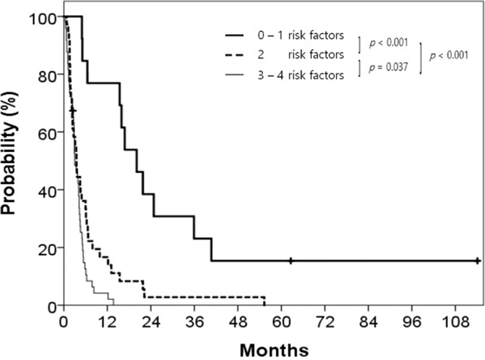글로벌 연구동향
방사선종양학
- [Sci Rep.] Prognostic factors for survival in colorectal cancer patients with brain metastases undergoing whole brain radiotherapy: multicenter retrospective study.
전뇌방사선치료를 받은 대장암 뇌전이 환자의 예후인자에 대한 다기관 연구이화의대, 서울의대 / 구태률, 김규보*, 지의규*
- 출처
- Sci Rep.
- 등재일
- 2020 Mar 9
- 저널이슈번호
- 10(1):4340. doi: 10.1038/s41598-020-61354-y.
- 내용
Abstract
Whole brain radiotherapy (WBRT) is a mainstay of the treatment for brain metastases (BM). We evaluated prognostic factors in colorectal cancer (CRC) patients undergoing WBRT for BM. The medical records of 106 CRC patients undergoing WBRT for BM between 2000 and 2014 at three institutions were reviewed. Patient and tumor factors were analyzed to identify the prognostic factors for overall survival (OS) calculated from the date of BM diagnosis to the date of death or last follow-up. Surgical resection of BM was performed in six patients. The dose of WBRT was 30 Gy, and boost radiotherapy or stereotactic radiosurgery (8-23 Gy) was given to 15 patients. Systemic therapy for BM was administered in one patient before WBRT and 26 patients after WBRT. The median follow-up time was 3.9 months (range, 0.4-114.1 months). The median OS time was 3.9 months, and the 1-year OS rate was 18.2%. Older age (>65 years), multiple BM (≥3), elevated level of carcinoembryonic antigen (CEA, >5 ng/ml) at BM diagnosis, and extracranial metastases were adverse prognostic factors for OS. Patient with 0-1 factor showed better OS (at 1 year, 76.9%) than patients with 2 factors (16.7%) or 3-4 factors (4.2%; p < 0.001). In conclusion, we evaluated age, the number of BM, CEA level, and extracranial metastases as the prognostic factors for OS in CRC patients undergoing WBRT. Our result might be useful to develop prognostic models predicting survival for patients whom WBRT is intended for.
그림.예후인자에 따른 생존곡선
Author informationKoo T1, Kim K2, Park HJ3, Han SW4, Kim TY4, Jeong SY5, Park KJ5, Chie EK6.
1
Department of Radiation Oncology, Hallym University College of Medicine, Anyang, Republic of Korea.
2
Department of Radiation Oncology, Ewha Womans University College of Medicine, Seoul, Republic of Korea. kyubokim.ro@gmail.com.
3
Department of Radiation Oncology, Hanyang University College of Medicine, Seoul, Republic of Korea.
4
Department of Internal Medicine, Seoul National University College of Medicine, Seoul, Republic of Korea.
5
Department of Surgery, Seoul National University College of Medicine, Seoul, Republic of Korea.
6
Department of Radiation Oncology, Seoul National University College of Medicine, Seoul, Republic of Korea. ekchie93@snu.ac.kr.
- 연구소개
- 결장암(Colorectal cancer) 환자 중 뇌전이 발생빈도는 낮지만, 예후는 아주 나쁘다고 알려져 있습니다. 여러 후향적 연구에 따르면 젊은 연령, 단일 뇌전이 병변, 두개외전이가 없거나, 암배아항원 (carcinoembryonic antigen, CEA) 농도가 낮은 경우 좋은 예후를 기대할 수 있다고 알려져 있습니다. 본 연구는 뇌전이로 전뇌방사선치료를 시행 받은 결장암 환자의 예후 인자를 밝히고, 그 예후인자를 이용하여 예측모델을 만들고자 3개 대학병원이 협력하여 연구를 진행하였습니다. 2000-2014년 동안 뇌전이로 전뇌방사선치료를 받은 106명의 환자의 치료결과를 분석하였고, 중간생존기간은 3.9 개월, 1년 생존율은 18.2%이었습니다. 나쁜 예후인자로는 고령(>65세), 3개 이상의 뇌전이병변 수, 뇌전이 진단 시 높은 CEA 농도 (>5 ng/ml), 두개외전이병변이 있는 경우였습니다. 전체 환자를 3 개의 예후그룹으로 나누었는데, 1년 생존율이 0–1개의 나쁜 예후인자를 가지는 경우 76.9%로 가장 좋았고, 2개 가지는 경우는 16.7%, 3–4 개 가지는 경우는 4.2%로 가장 나빴습니다 (p < 0.001). 본 연구에서 밝혀진 예후 인자를 대규모 환자군에서 확인하고 가중치를 부여하여 정밀한 예후예측모델을 개발한다면, 세기조절방사선치료를 이용한 정밀한 기법의 뇌방사선치료를 선택적으로 적용하여 뇌전이가 발생한 결장암 환자 중 좋은 예후를 가진 환자의 생존율을 더 향상시킬 수 있을 것입니다.
- 덧글달기









